#most of the other worlds in the book are more traditional fantasy though if that's more your vibe lol
Explore tagged Tumblr posts
Text

The kickstarter for Book of Devotion is now live!
Book of Devotion is an artbook dedicated to clerics, paladins, and the divine beings they worship. I've gotten very fond of the weirdass technocleric I designed, and I'm excited to share more about them (as soon as the mods let me). In the meantime though, the kickstarter will be open from April 29th to June 13th.

#book of devotion#im very proud of my team hahaha i love the cyberpunk genre and i think everyone did such cool and weird riffs on the concept we decided#shoutout to dan our writer especially! their worldbuilding is incredible and i am very happy to have drawn for it#most of the other worlds in the book are more traditional fantasy though if that's more your vibe lol#eeeeeeek im so excited#beepbeep.txt#pinned
266 notes
·
View notes
Photo

The Bright Ages: A New History of Medieval Europe
"The Bright Ages" dispels the common myth that the Middle Ages were dark, backward and brutal. The book weaves a new history of the Middle Ages, examining over a 1000 years from the 5th to the 16th centuries, arguing that the "Dark Ages" are a modern ideological myth and that the Middle Ages were far more luminous, tolerant and diverse than they are commonly believed to be.
Each chapter of the book examines key developments in time and space across Medieval Europe, starting and ending in Ravenna, Italy. It covers:
the late Western Roman Empire
the Byzantine Empire,
the Goths,
Anglo-Saxon Britain,
the Franks,
the Vikings,
France,
the Black Death,
the Crusades,
Christian-Muslim-Jewish relations in Spain,
the Caliphate,
Hildegard von Bingen,
monastic orders,
the Golden Horde,
the Black Death
and much more.
The book centers on several compelling arguments that are not commonly considered when thinking of the Middle Ages.
First, the authors argue that the Roman Empire did not fall in the Middle Ages. The so-called "fall" of the Western Roman Empire was not understood by medieval people to be an end to the Roman Empire. It was merely a shifting of the centre of power from Rome to Constantinople. In the medieval mind, the Roman Empire was alive, powerful and respected (until it finally fell at the very end of the Middle Ages in 1453). Equally, various rulers in the Middle Ages claimed a connection to the Roman Empire to justify their rule.
Second, the book argues that the Middle Ages were far more diverse and interconnected than most people believe. People moved freely and frequently between countries and cultures, both within Europe and between Europe, Africa and the Middle East. With them came ideas, knowledge and goods. The idea that, during the Middle Ages, Europe contained "purer" nations is an ideological fantasy conjured by nationalists:
Throughout the eighteenth and nineteenth centuries, imperialist European powers and their intellectuals (often the forerunners of, or scholars in medieval studies themselves!) sought a history for their new world order to justify and explain why whiteness –a modern idea, albeit with medieval roots– justified their domination of the world. They found the proto-nations of the Middle Ages useful as a past to point to for their modern origins, pointing to both medieval connections to Greece and Rome and the independence and distinct traditions of medieval politics. These modern thinkers used the fiction of Europe and the invented concept of "Western Civilization" as a thread to tie the modern world together.
Third, the book highlights at several points that power was less concentrated in male authority than commonly believed. Throughout the Middle Ages, women held positions of power and their power is attested in medieval primary sources. Abesses could be superiors of monks, kings wrote to Hildegard von Bingen for advice, Leif Erikson's sister led an expedition in Newfoundland, and some Queens were responsible for the Christianisation of kingdoms, to cite a few examples.
Finally, the book argues against the connotation of the term "medieval" signifying "backward". In fact, the authors show that even though religion played a more central role in society than in the modern era, the Middle Ages was a humane society concerned with what is moral and good, despite the cruelty that occurred in this era like in any other. The epilogue suggests that European colonisation represented the real "dark ages" by recounting a debate about whether the natives of the New World could be considered human and what rights the Spanish crown and landowners had over them.
Overall, The Bright Ages paints a new picture of the Middle Ages filled with nuance and diversity. Unlike popular Medieval tropes, the Middle Ages were far more complex and less dark than we commonly believe. The myth of the "Dark Ages" is a modern one, and to truly understand, we must dissociate from it.
Matthew Gabriele is a professor of history at Virginia Tech, and David Perry was a professor of Medieval History at Dominican University. The book is written with the general public in mind and is easy to read. Each chapter is engaging and many of them refer to key events in Medieval history that most readers would be familiar with. However, a reader with no knowledge of Medieval history might find the book hard to follow.
Continue reading...
98 notes
·
View notes
Text

Basic Information
Birthday: 19th of April (Aries) Age: 16 Height: 1,62cm Dominant hand: Right Homeland: England, Earth Nicknames: Blue jay, herbivore (by Leona) Gourami (by Floyd) Mademoiselle Brillant (by Rook)Wen-wen (by Cater)
Family: Unnamed parents † Jordan & Myles Beaumont (young brothers)
Grade: Freshman Class: B Club: School’s janitor team Best subject: Astrology
Hobbies: Storytelling Pet peeves: Arrogance Favorite food: Blueberry muffin Least favorite food: Mustard Talent: Sewing

Background:
Whitney had always thought she grew up in a close-knit family. That was the fantasy she clung to, but the truth was far bleaker. In 1900, her family seemed perfect to outsiders, yet behind closed doors, her father crushed any spark of imagination she had. Like so many women of the time, she was only allowed to do her chores, never to dream of anything more.
When she was just 10, tragedy struck. Her parents died in a car accident, leaving her and her younger brothers, Jordan and Myles, utterly alone. They were sent to a cold, joyless orphanage where Whitney, now Winnie to her brothers, was forced to grow up far too soon. She took on a motherly role for Jordan and Myles, comforting them as best she could, even as her own heart ached with loss.
Her only escape was in the world of fairytales and fantasy. She spun stories for her brothers, clinging to the magic in her mind to protect herself from the harshness around them. But the orphanage director disapproved. He called her dreams foolish, telling her to face reality and abandon her "silly" stories. Each time he scolded her, Winnie’s fear of growing up deepened, terrified that adulthood meant losing the last bit of wonder she had left.
One cold, lonely night, after yet another argument with the director, Winnie found an old, forgotten book at the orphanage door. Desperate for hope, she wished upon a falling star for a better life and drifted into a deep, dreamless sleep. When she awoke, it was not in the orphanage, but inside a coffin in the strange, magical world of Twisted Wonderland.
Personality:
Winnie carries an air of being old-fashioned, a product of the early 1900s that shaped her upbringing. Her values reflect the time she grew up in—modest, traditional, and deeply rooted in responsibility. She holds onto a sense of decorum and duty, often placing others’ needs before her own, and is naturally polite and respectful. Despite living in a strange new world like Twisted Wonderland, she still clings to the manners and customs she was taught as a child, sometimes feeling out of place in the more modern, freer ways of others.
Her old-fashioned nature also makes her somewhat reserved when it comes to change, often questioning the bold or reckless behavior she sees around her. Yet, her respect for structure and tradition is in direct conflict with the free-spirited dreamer inside her. This paradox makes Winnie both nurturing and cautious, but also curious and rebellious, wanting to balance the world she was raised in with the one she now finds herself navigating.
Her love of fairytales and storytelling, too, stems from this old-world charm, where she believes in timeless ideals of honor, loyalty, and sacrifice. Though some may tease her for being "out of date" or too "old-fashioned," Winnie remains true to herself, blending her deep-rooted values with the spark of imagination that keeps her moving forward. This makes her a fascinating mixture of someone who respects the past but isn’t afraid to rebel against the limitations it tried to impose on her.

Trivia:
Whitney is inspired at Wendy from Peter Pan.
Her last name is the same as her voice actress and portrait actress, Kathryn Beaumont.
Her birthday is the year 1904, but separate! This is the year Peter pan’s movie is portrayed.
Whitney loves stargazing.
Whitney call most people around her “Mister”, “Sir”, “Ma’am”, “Miss”, even if they are the same age.
It is not considered that she time traveled, since she went from one dimension to another, who just is more developed; still not a time travel since dimensions’ timezone don’t work in the same way.
Epel says at the end of every class Whitney falls asleep in her table like Silver; however, most teachers don’t wake her up, nor encourages students to do so.
In Book 2, Leona said Whitney first put a small pillow on the floor of his room where she would sleep, once he gave the idea of her using an mattress, Whitney said “I am used to sleep on the floor, no worries.”
Ortho and Idia eventually help her understand technology in Book 6. Understanding that from where she came from this was not normal.
In Book 5, Vil helps Whitney understand more about the modern world. Something that Cater has also been doing since Book 1, just not, as successful.
Riddle tries to be easygoing with Whitney since he mentioned multiple times she had cry a bit scared of him, during Book 1 he noticed but payed no mind to it. Then he find out that she acts like it because of the orphanage director.
Jade doesn’t like her because she doesn’t like mushrooms; that’s duo the only thing she could eat when disrespect someone of the orphanage staff was mushroom soup.
Whitney only wants to go back for her brothers, because if they were there together in Twisted Wonderland; she wouldn’t want to go back at all.
Leona calls Whitney “blue jay”, because he always forget her name.
Dylla Spade (Deuce’s mother) said if she ever wanted a different place to stay with her siblings, her house would always have open arms to her. And constantly implied she would love to have more kids around, awhile talking with Whitney.
Whitney not liking/caring for the Octotrio, is duo to the fact Wendy in Peter Pan (1953) was attacked by mermaids.

#. ݁₊ ⊹ . whitney beaumont#my writting | 𝐛𝐫𝐛𝐬.#my art | 𝐛𝐫𝐛𝐬.#twst yuu#twst wonderland#yuu#twisted wonderland#twst fanart#disney twisted wonderland#twisted oc#disney twst#twst oc#twst art#twst#twist wonderland#disney
52 notes
·
View notes
Text
Every time a new Brandon Sanderson book is released everyone updates their suggested reading order but all you need is the patience to be uninformed and enjoy the book!
But depending on your preference the best story to start with will be different.
If you want a crash course on the basics of The Cosmere's magic physics (Aka Investiture) so you can hypothesize on how other magic works I suggest the short story "The Emperor's Soul" as a starting point, it gives a solid overview of Realmic theory and covers Identity (a rather difficult idea to communicate) very effectively. (this is the start of the PhD route)
If you want something that's more like a traditional fairy tale as an intro I suggest Tress Of the Emerald Sea, which doesn't require a PhD in the shattering to understand. (though if you're going the PhD route I suggest reading this one later because if you're questioning the magic it's a far more confusing one)
Warbreaker is a good middle ground, if you're going the PhD route I suggest this second (it covers Intention which "The Emperor's Soul" doesn't), It's not a bad starting place either, it was my first book in The Cosmere and it's up for free on The Sand-Man's website. It's also all-around an excellent book.
I'm going to be (a tad) controversial and say I enjoy Elantris, it's certainly not Brando-Sando's best work but it was his first, and it's not a bad book to start with! just keep in mind that many of the issues in the book are things he improves on in later books.
Mistborn is two (soon to be 3) series, we distinguish them by 'Era' and they should be read in order if you want to make sense of what's going on.
Mistborn Era 1 (3 books) is also an excellent place to start, it's a YA-style series so you follow a teenager in a Post-(more like perpetual)-Apocalypse, but it's also an Epic high fantasy so if you like those and don't mind romance It's a good one.
"Mistborn Secret History": read this after Mistborn Era 1 if you're going the PHD route read anytime before The Lost Metal (Era 2 Book 4) for everyone else. (PhD track: if you want the most out of it I suggest also reading White Sand first)
Mistborn Era 2 (4 books) is a high fantasy Western set in the same world much later in time, 10/10 no notes, it's excellent.
The Stormlight Archive, TheBigOne™ It is planned to be a 10-book series with accompanying Novellas. I suggest reading in chronological order including the short stories, published so far that would be:
The Way of Kings
Words of Radiance
"Edgedancer" (novella)
Oathbringer
"Dawnshard" (novella)
Rhythm of War
Start with this series if you thirst for sprawling high-fantasy novels with page counts that would make grown men weep (the Audiobook for RoW was like 48 hours long)
The entirety of Arcanum Unbounded is not required reading, (unless you're on the PhD track) but it contains both "The Emperor's Soul" and "Edgedancer", you should probably read Elantris, Mistborn Era 1, Alloy Of Law (MB Era 2 Book 1), and Stormlight (up to Words of Radiance). If you enjoy Graphic Novels and dislike spoilers/rereading stuff when you haven't finished it yet I suggest skipping the White Sand excerpt.
White Sand is also not a terrible intro, it covers a theme in B-Sandy's work that isn't directly related to the cosmere but will give you a good insight into whether you'll like his work or not: the idea that skill is developed, not just inherent. if you're like me and dislike graphic novels GraphicAudio™ (actually a company not a joke) Has an Audio rendition that has some narrative differences from the Graphic novels (iirc at least one character is a different gender) But the Graphic novels also have a random boombox on a planet with no electricity so either should be fine.
Yumi and the Nightmare Painter is in a similar situation to Tress of The Emerald Sea except instead of a classic European Folktale Vibe it's got a Western Interpretation of Anime Vibe, ofc it's high fantasy like all Sandon Branderson's work so it's world is inspired by Japanese culture rather than just being Japanese.
The Sunlit Man read Shadows for Silence in the Forests of Hell (Arcanum Unbounded), and at least Oathbringer (Stormlight Archive 3) before this one, unless you like being thrown into the deep end, Mistborn Era 1 & 2 would also help.
There are other routes than Ph.D., there's also the Galactic Politics route, The Secret Society route, The Worldhopper Watcher route, The Ancient History route (Aka The Shattering route) ect
if you want specific reading route recs just tell me what you're looking for I can help!
#brandon sanderson#cosmere#reading order#cosmere reading order#technically I'd call this spoiler free#unless you consider overarching themes spoilers#which is dumb you shouldn't do that#stormlight#mistborn#sixth of dusk#tress of the emerald sea#yumi and the nightmare painter#elantris#B-sandy
71 notes
·
View notes
Text
Werewolf Thoughts - Day 31, Happy Halloween!

Day 31- Happy Halloween! For the final day, I just want to expand upon how, as preposterous as it may seem, I really cannot put into words how much the concept of this curse of the werewolf captivates me. There are endless elements to explore and stories to tell with such a thing (and I am going to tell as many as I can, myself, in my own fiction). The distant howl of a beast, wolfish yet wrong, drifting over the graveyards and haunted forests under the light of the full moon as the air hangs thick with fog-- knowing it is the voice of a cursed monster but also of an innocent soul, haunted, powerless, enduring the untold agony of the transformation and now indescribably dangerous… cursed, lost in rage with which no man could contend, and always starving for flesh.
It is one of the deepest tales of tragedy. The werewolf is a being of duality, of halves, never to be truly whole. Neither a man nor a beast, they must wander, alone, lost, at odds with themselves, in sorrow, fury, and eternal hunger. How does one reconcile committing atrocities in the skin of a beast? How can any good person continue as such a monster?
It gives me chills just thinking about it. I've never seen a concept cooler, and I know I never will. You cannot best the oldest of legends and such a core terror that haunts all humanity: the idea that even the most civilized a man could become the most terrible of beasts. This is why werewolves have haunted the human psyche since the dawn of time - and they always will.
Obviously, there are many takes on werewolves, especially these days, and not all folklore told such tales, but I'm speaking in terms of why werewolves captivate me personally. To me, it all comes back to The Wolf Man (1941), as inspired by legends and turned into a tale of tragedy that touches the hearts of all who hear it. You cannot help but relate to such a character, feel sorry for him, but you always must wonder… what would you do, in such a situation? What would you do, as a werewolf - or as a werewolf's loved one? What would you do, if someone you cared about turned into a monster?
That is untold narrative power.
As always, I have endless werewolf thoughts all the time, not to mention publishing werewolf articles, folklore research, and much more. I am also finally getting into publishing my werewolf fiction, which has always been my truest life goal.
November this year (or December if things go sour for me, but hopefully November), I will have a new release called Wulfgard: The Prophecy of the Six, Book I - Knightfall. It's the biggest deal to me. I've worked on this story my whole life and been editing this huge revision of it for almost ten years. It means so much to me. And I'm so proud of it. I can't wait to publish it and share it with the world.
I really hope you'll check it out. So be sure to check back with me for its release and pick up a copy (or maybe even take part in some fun giveaways and other things I have planned). It's kind of like Lord of the Rings meets The Wolf Man. If you love traditional fantasy, adventure, horror, werewolves, knights, mystery, and even pitched battles, this book has it all.
For now, though, I have to get back to work on said book. I hope my werewolf post series here has been fun, thought-provoking, and even educational. I do this kind of thing all the time, but I've never done a once a day series. It's been a blast.
So, once again - happy Halloween!
img: art of werewolf Tom Drake from Wulfgard, by Saber-Scorpion
#werewolf#werewolves#folklore#lycanthropy#halloween#happy halloween#transformation#monsters#fiction#books#wulfgard#thoughts
20 notes
·
View notes
Text

The beginning of Tzeentch. In this post I will explore where Tzeentch came from, and his earliest mentions and depictions, and his likely inspirations.
Realm of Chaos Book 1, 1988, picture of Tzeentch.
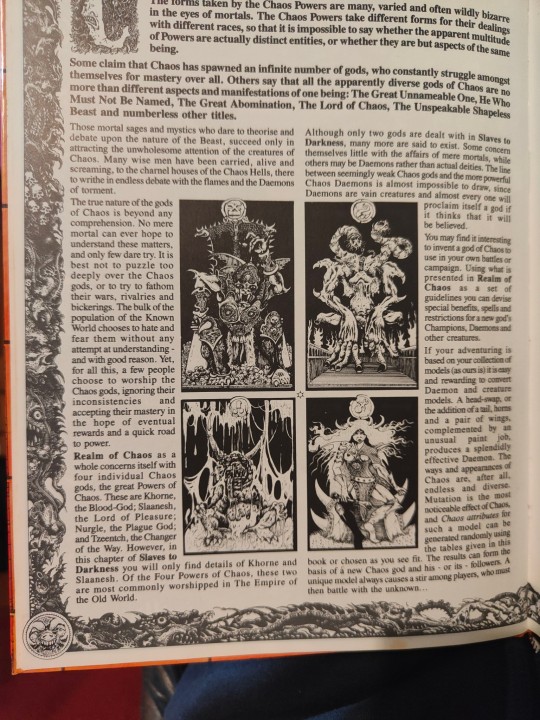
This is the earliest depiction of Tzeentch I've been able to find in the history of Warhammer publications.
Prior to this only Khorne and Nurgle were described in Warhammer fantasy roleplay 1986.
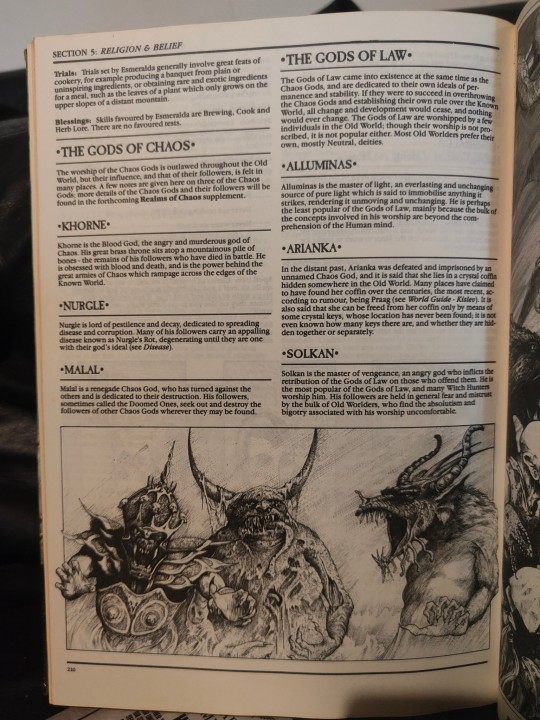
The earliest list of the Chaos gods names (and therefore the earliest printing of the name 'Tzeentch') I've been able to find, is from Warhammer 1st edition, Forces of Fantasy 1983 (first paragraph at the top of page 40) though it gives no description or depiction of them.
'... worship a documented god (Khorne, Slaanesh, Nurgle or Tzeentch at the time of writing)...' either Rick Priestley or Bryan Ansell in 1983

The image of Tzeentch appears to be kept consistent in modern editions as seen in this picture from Age of Sigmar (1st ed 2017, Disciples of Tzeentch)

And the description given of Tzeentch in the realm of chaos book is repeated in the Warhammer armies Chaos 4th & 5th edition, liber Chaotica Tzeentch, codex chaos etc. (pictured below is the description from the liber Chaotica (2005) followed by the description & adjoining picture in the realm of chaos book 2 (1990)


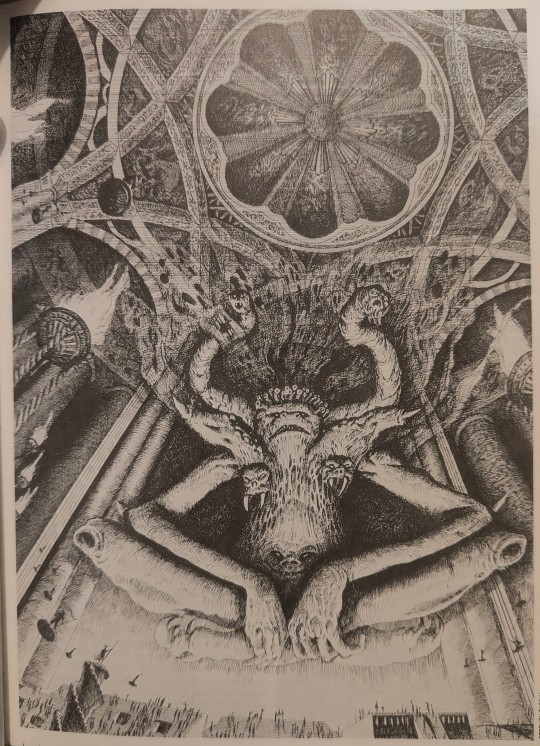
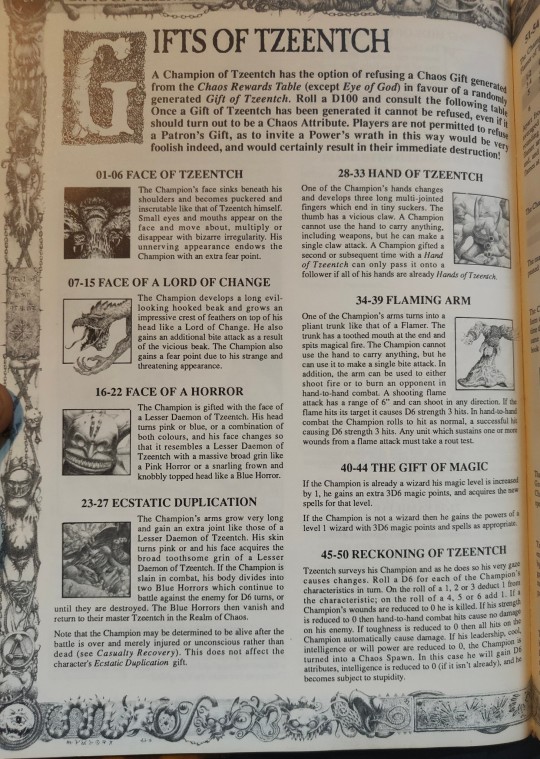
The face of Tzeentch is even given as a champion upgrade in the realm of chaos (1990), showing a cut of this much larger picture found elsewhere in the same book.
To definitively conclude this: Tzeentch is a big horned horror. Just like a big pink/blue horror, with two main arms, & two horned limbs right above his main arms, and two great big sweeping horns from above his brow which look more like moving snakes with faces on the end. He has a main face around his shoulder level, two smaller faces below on either side, and a large face across his belly. Any other faces are presumably transitory.
'Tzeen' means 'change' in the dark tongue, and 'neth' or 'leth' mean 'lord'. Hence Tzeeneth means Change-Lord. Its common form in the language of the empire or Imperium is Tzeentch
The inspiration for Tzeentch are most likely gods like Arioch, of Micheal Moorcock's Elric of Melnibone saga, and Nyarlathotep of H.P. Lovecraft's Cthulhu mythos.
The 2nd Edition of Warhammer Fantasy Battles has a dedication to Michael Moorcock, Phil Barker and Donald Featherstone.
Moorcock's Elric of Melnibone saga (1960s) creates the Chaos - Law paradigm, where there are two sets of opposing Gods. Arioch is the main Chaos God and his relationship with Elric is highly characteristic of how Warhammer would go on to depict the relationship between a chaos champion and their god.
Whilst Chaos and Law appear superficially attached to evil & good, this becomes questioned as Moorcock eventually presents the idea that progress is only possible with a balance between chaos and law, as to live in a world of pure law and tradition would allow no change, and a world of pure chaos would live every day as if it was the first never progressing past it.
This likely inspired the early Dungeons and Dragons writers as well and is probably the reason Chaos & Order exist on a perpendicular axiom to Good and Evil on alignment charts in D&D. The early Warhammer writers were reacting towards D&D and inherited much from them (1st ed citadel miniatures from white dwarf issue 12 were 'advanced dungeons and dragons' minis).
The Moorcock's Elric of Melnibone is also likely the source for the idea of mutation in the Warhammer sense, and is likely the inspiration for the idea of Daemon Weapons, and Sentient Weapons.
Lovecraft is better known these days than Moorcock and probably needs no introduction. It's clear the eldritch ancient horrors of the Great Old Ones and their endless conspiracies to find a way (back) into reality and take it over, also inspired the idea of 'chaos' in both dungeons and dragons and Warhammer. The madness which comes from the Necronomicon and knowing it's secrets, echoes the madness followers of chaos might expect when learning more about the warp and their god. Stories like the Dunwich Horror could as easily be describing a daemonic incursion in the Warhammer world with little alteration needed.
The fusion of Moorcock's and Lovecraft's lore appears to be the inspiration for Chaos. They define the concept of a god without it being all powerful, and foreshadow the different relationships that are created between mortal followers of chaos and their gods. They introduce the themes of mutation and madness which characterise Chaos, thereby appearing to be the ingredients of what became Chaos in the Warhammer sense.
Khorne appears little more than a classic war god in this Warhammer-Chaos veneer, and likewise Slaanesh is clearly inspired by a unification of Astarte, Dionysus, & succubi/incubi in a manner reminiscent of the Christian Devil. Perhaps considering Khorne's image and that of his blood letters, one could conclude that both Khorne and Slaanesh look heavily towards the Christian Devil for inspiration, albeit in different ways.
Nurgle is loosely presented as a death god, and one day I'll look into his inspiration properly. Similarly Tzeentch is presented as a god of sorcery. It's suffice to say here that neither Nurgle nor Tzeentch draw as much from ancient mythology, as unlike Khorne and Slaanesh, their personalities are utterly antithetical towards the personalities of the ancient gods of death and magic which they would nominally be attributed towards. It is my opinion so far in researching this that both Nurgle and Tzeentch draw far more heavily on Moorcock & Lovecraft than the other two, uniting the themes of mutation and madness in chaos and more purely attempt to capture the very essence of Chaos itself. It seams as if Nurgle is the abundant manifestation of chaos and Tzeentch is the distilled essence of chaos.
#tzeentch#chaos gods#warhammer 40k#warhammer fantasy#chaos daemons#warhammer art#games workshop#chaos warriors#chaos#thousand sons
40 notes
·
View notes
Text
2025 Book Review #74 – The Glory of the Empire: A Novel, A History by Jean d’Ormesson
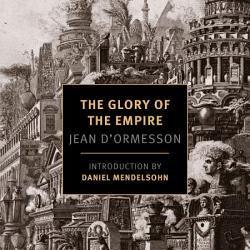
I found this, frankly, leafing through my bookshelf looking for a final book to read this year. I have a chunk of my bookshelf devoted to history books from university I never did more than skim through the introduction of, and at a glance at the cover and name I’d always assumed it was one of those. As it is actually a work of rather literary alternate history written by a French guy in 1971 I have literally no idea how I ever came into possession of it. However it happened this is, sadly one of those cases where it’s a book that’s almost written specifically for me, and is instead just a few degrees off and entirely intolerable.
The book is a history, though one of an empire that never existed. It arose and spread across the world in a vague era I can only really describe as ‘Xena Warrior Princess times’, shaping the history and cultures of everything that has followed. The book is written in the style of one of the more self-assured and grandiloquent monographs of the era, full to bursting with references to the historiography and the cultural memory of the events being described, and symbolic and psychoanaltyical perspectives on the people involved. The the book charts the vaguely Hellenistic, vaguely Byzantine empire’s rise, fall, and greater rise still across the centuries, mainly through the biographies of its three great unifiers.
Deciding what I think of this has been difficult because, as an artistic project it is a complete sense. As a matter of form it mimics (and exaggerates) the histories its based on near perfectly, and its themes are clearly are woven through the entirety of the text. Great care has clearly been taken with everything from the fake bibliography to all the ‘preserved fragments’ of poetry and the quotes put in famous figures mouths.
Perfectly executed it is just, awkwardly, a project I find somewhere between gratingly unenjoyable and actively loathsome. As a novella, it would have been a really interesting experiment in form – at 450 it’s a painful struggle. It does at least make for an interesting reading experience, if not one I can exactly recommend.
The best way that I can sum up the book is all the most irritating and tiresome tropes of old antiquarian histories, exulting in liberation from any obligation to those tedious and limiting facts and existing traditions which might restrain them. The result feels less like any sequence of events which might possibly have occurred and more like the lore of a rather generic fantasy setting.
In terms of style, the narrator drones. He bombards you into one lengthy and enumerated list of no consequence after another. He goes on long digressions about the fun anecdote leading to the discovery of a source that were presumably entertaining to him. He gestures towards the significant contributions of other schools of history as a polite aside and then ignores them entirely. He just, generally, reads like someone getting paid by the word.
As for tropes – look, this was published in the early ‘70s, a certain level of casual racism is kind of just the price of admission. But this really was just distractingly Orientalist. The constant presence of the savage barbarian hordes filling the Eurasian steppe, knowing nothing but war and bloodshed and always on the verge of overwhelming and destroying civilization, is presented as a simple and enduring fact of history. The essential and unified nature of ‘Eastern mysticism’ plays a key part in the plot. In this history stretching across all of Eurasia, Africa south of Egypt and Carthage simply does not exist except as a source of slaves. And so on – I suppose I really shouldn’t be surprised by this, any more than the occasional mentions of (male, of course) homosexuality exclusively as a symptom of decadent and effeminate urban decline, or the fact that there are (barely, and being generous) a grand total of two women with any significant at all beyond being a romantic prospect or mother of someone who really mattered.
In structure and thesis it is the greatest of Great Man histories, full of the world being shaped and remade by the epoch-defining virtues and faults of a small handful of epoch-defining emperors, ministers and saints who sweep away all before them. Logistics simply do not exist, political organization and grand strategies are organized across a span of continents without issue, every conflict is preordained by which side the Great Man of the moment happens to be on. Whole chapters of the book are devoted to giving the personal biography of the Emperor Alexius before his rise to power – chapters which feel less like reading the biography of person who might actually have existed and more like aan overlong Wikipedia article summarizing the exploits of the hero in some decades-old serial franchise. His adventures are all-but-explicitly compared to the Alexandrian Romance as a genre, but without any of the cultural context or comparisons over time that make that inspiration actually interesting.
All to say that yes, it is an excellent reproduction of a particular style of old history – and I am wholly agnostic on whether everything I just complained about is a flaw of the author or a testament to the skill of their imitation. It’s just not a kind I’ve ever found anything but tedious to read, and without the redeeming virtue of having any sort of reality to peer at through the fantasy, or a fantasy that was particularly compelling to read about on its own merits. Or I suppose some readers may find all the attributions of famous sayings, events and fables to the book’s characters intriguing or charming? Given the density and blatantness of them I just quickly found it eye-roll inducing. And without that colour the history has less drama or tension to it than the lore of your average Dungeons and Dragons setting. And as personal drama and character work – well, remarkably few plots are improved by being told in the form of a meandering essay that spends more time hammering you in the head with what glorious, world-historical love stories they are than actually telling you the story.
The books themes are quite explicit and all but didactic – about the relationship between history and fiction, and how every historian is creating their own reality and imposing their narrative on a loose scaffolding on fact and memory. Which is an entirely fair theme for a work of fiction, and I assume not quite so tired a one back in 1971. But my god are both popular and academic histories these days better about it. I have in the past joked about how ‘well isn’t that kind of reductive/oversimplifying’ has been every historian of the last two generation’s default response to any sort of theorizing or edifice-building of any kind, but this book has done an excellent job reminding me how preferable it is to the sweeping, mytheopic alternative.
Anyway yeah, intellectually interesting enough that it might have been
#book review#the glory of the empire#Jean d’Ormesson#literatre#french lit#20th century#in translation
14 notes
·
View notes
Note
The whole point of Fire and Blood is white supremacy. Viserys didn’t want Argon as king because his blood was not pure enough, he was of “Alicent blood”. So why, if they wanted a black and white moralistic show, they are on the side of white supremacy.
An important thing to recognize, that the writers and fans fail to see, is the fact that GRRM wrote the ASOIAF series as a subversion of common fantasy tropes. Good and just royals, chivalrous and honorable knights who protect the innocent, prophecies as a force for good, enlightened and benevolent magic race of beings, fairytale love stories and happily ever agrees, clear black and white stories of good vs evil... all of these things GRRM wrote to subvert in his books. Royals play their game of thrones and are concerned with their own power most of all, knights are not always good people or honorable and in fact are tools of an oppressive system, no race is inherently superior and believing this drives violence and destruction of those very people, people marry for duty and duty is the death of love, and there are no clear cut black and white conflicts in the real world, just complex and nuanced situations where both sides think they're right and do what it takes to reach their goals for their own reasons. This subversion of fantasy tropes and elements in favor of a realistic exploration of what the sociopolitics of those worlds would be is something that defines the ASOIAF series and sets it apart from the rest. The faithful adaptation of these books and maintenance of those subversions and the integrity of the underlying themes of the works is what made the early seasons of Game of Thrones such outstanding and praiseworthy television.
The writers of House of the Dragon do not see the truth of this. Instead, they have co-opted symbols of fantasy and other surface level elements present in the ASOIAF series and used them to construct a story more in-line with traditional fantasy stories. In their hands, the conflict is a black and white morality tale of good vs evil that presents a magical race of people as superior to others and presents prophecy as an uncritical force for good and justification for a devastating war. Sprinkled in are characteristic yet surface level shock value factors - like incest and extreme violence - that were present in Game of Thrones. Ironically, their writing is antithetical to the ASOIAF series and what GRRM set out to write with his stories. This is the fundamental issue with House of the Dragon and the ultimate failure of its adaptation.
Because the writers and fans have bought into an unsubverted fantasy story, they choose to support a race of people who believe themselves superior to all others and the violence they use to keep control of their subjects. The critical view of fantasy as a genre and stories set in medieval feudalism are entirely lost on them, beyond a surface level, modern viewpoint focusing on one isolated element of oppression that existed in those times. Because the story only focuses solely on the dimension of misogyny as a system of oppression and fails to acknowledge its intersection with other systems of oppression present - racism, classism, and ableism, namely, among others - it fails to fully explore the dimensions of power present in this society and therefore its politics feel limited and messages feel shallow. It's the focus on misogyny and setting aside of all other dimensions of oppression that firmly centers this show on a white feminist perspective, to its detriment.
All of this said, to the first part of your ask: I don't think that was really a reason for Viserys' decision to not make Aegon is heir. Even though it certainly is an instance of him othering his children by Alicent and viewing them as separate from Rhaenyra, he supports Rhaenyra as heir because she is his favorite child and the child of his first wife. The context of the line concerns when Alicent proposes a union between Aegon and Rhaenyra and Viserys dismisses the idea because he thinks her sole motivation is that she wants her own bloodline on the throne, which to be fair to Alicent is what anyone would want in her situation. It's not necessarily of him not having "pure" blood per se. If something like that was really an issue to him, he would have wed a Valyrian, and he did have the option to do just that; instead he married Alicent and has multiple children with her.
Aside from Viserys' wishes, Targaryen supremacy is absolutely linked to white supremacy. And so many choose not to see it in lieu of uncritically seeing Targaryens as actually belonging to a magical, exceptional, and superior race of humans. Their buy-in to this fantasy trope is in opposite to the actual intentions and goals of the original author.
#asks#anti hotd#white supremacy is 100% linked and a huge part of this adaptation#consciously or not the decisions made in this adaptation are solidly white feminist#when it never ever should have been at all
26 notes
·
View notes
Text
In defense of ‘House of the Dragon’ costumes.
I doubt anyone will read this, but at least I can link to it instead of arguing with people.
I don’t even like the costumes that much, truly, but every fucking time the criticism is paired with examples of the costuming work on ‘The Borgias’, ‘The Tudors’, or even ‘Reign’. I have thoughts on the costumes from those shows too, but will readily admit they do have more detail and texture than most garments worn in HotD.
HOWEVER
Whenever I hear these mentioned in comparison I want to scream.
Tudors is set in 16th-century England.
Borgias is in 1490-1500 Italy
Reign [allegedly] depicts mid 16th century Europe.
None of these have examples of medieval fashion. The middle ages spanned from the 5th century to the 15th (and by then, the renaissance movement had come to Italy, so the Borgias does not depict medieval clothing, either.)
ASOIF is a fantasy universe, true, but GRRM has stated many times that the Middle Ages served as a basis for the world he created and that historical realism was an important grounding factor for making the universe feel real, too.
I think it’s fair to say this should apply to clothing, just as it applies to decor, atmosphere, and technological advancements in both the books and the show. Clearly it is supposed to replicate the middle ages, or a very similar equivalent in Westeros.
I’m happy to suspend some disbelief given the fact it is a fantasy setting—for example none of the garments in GoT were historically ‘accurate’ but the more traditional gowns kept a silhouette and stylistic details that were similar to garments from the 15th century [most pointedly Sansa’s and Cersei’s gowns from the earlier seasons] which would fit the period in history that influenced the books.

I genuinely think HotD was trying to do something similar, drawing from fashions from the slightly earlier 1300s/1400s—which follows with the established timeline.
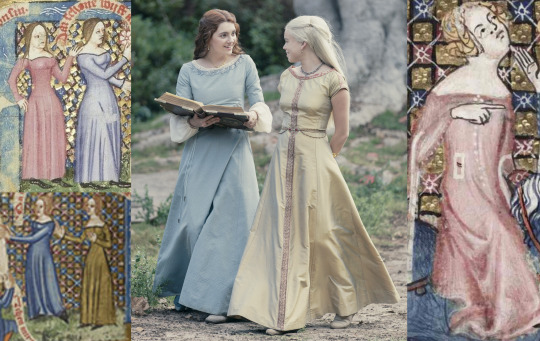
And, obviously, that is very much not the time period shown in borgias, reign, or the tudors. It is in fact HUNDREDS of years earlier.
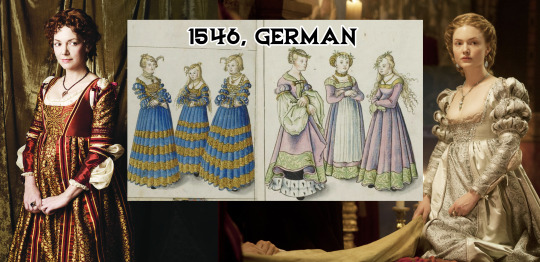
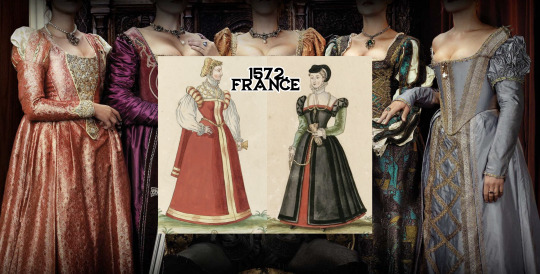
To put this into context:
Comparing the 1300s to the 1500s is equivalent to comparing your wardrobe to what is in a Jane Austen film.
Comparing the 1500s to the 1700s is like comparing civil war era uniforms to what is worn by the military today.
A lot changes in 200 years.
And you know what? Garments in the 1300s weren’t that pretty.
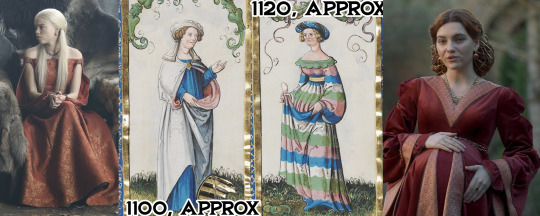
Almost all of them lacked closures, which meant they went over the head and were shaped with belts or ties.
Corsets were not worn during this period so any sort of tight, supportive, and shapely bodices in this era is a thing of fiction.
Though layers were often worn, they were typically only visible at the hems and not the neckline [so the layers of a partlet/visible chemise as seen in the 16th century was unlikely, too].
In fact the only realistic depiction of this period I've seen in costuming is on the show “Hollow Crown” and do you know what those dresses looked like? Well…
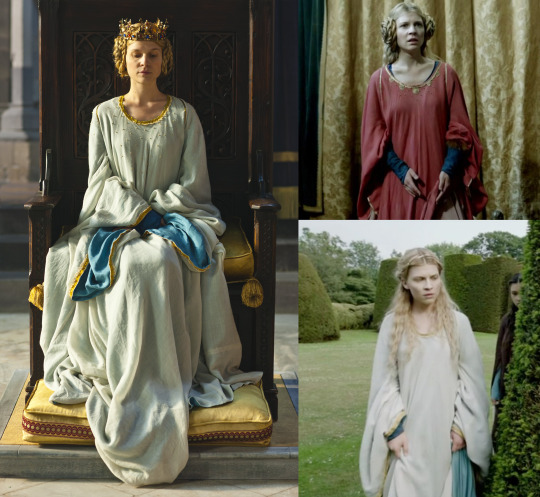
Not to mention this is a difficult period to research in general since so little paper survived. This website has timelines for fashion, and where the 15th century page features a dozen examples for each decade, the 14th century page has less than a dozen examples TOTAL.

Now I’m not saying the costumes couldn’t have been better. I do think fabrics with more texture could have made even the simple gowns look more interesting, and I wish the amazing embroidery that we saw hints of was better utilized.

But, I think given the historical examples the designer was probably tasked with interpreting in a fantasy setting, the costumes are just not going to be as fantastic as what you see in dramas from later periods.
(The wigs however were unforgivable, i’ll give you that, lol. )
ALSO I'm not saying you can't complain about them or think they were ugly. I'm just saying that if you are going to compare them to something, please compare them to garments from other fantasy dramas, or things that actually take place in the same period.
Ok. Rant over.
#game of thrones#house of the dragon#costume design#costume#targaryen#hbo#historical#medieval fashion#middle ages#medieval dress#rant
74 notes
·
View notes
Text
2024 Books - Year in Review
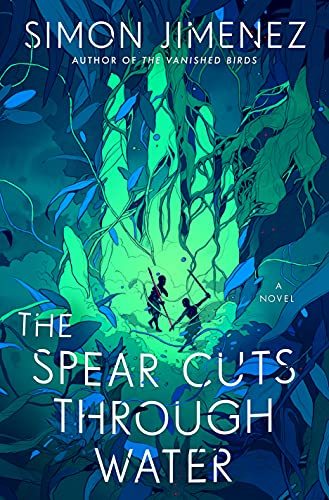
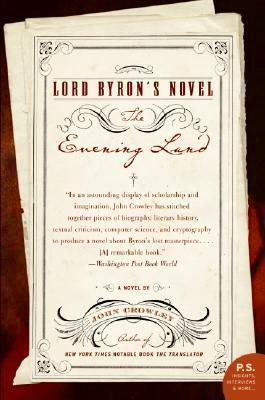

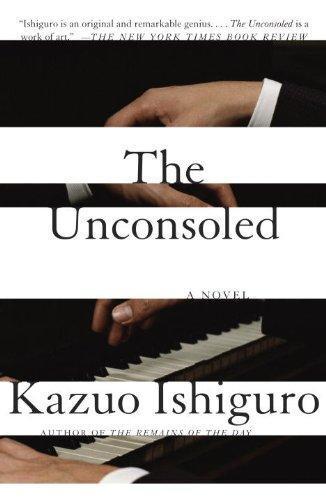
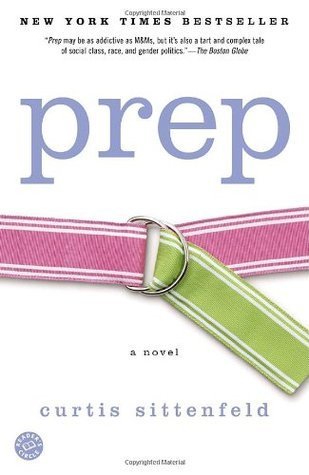
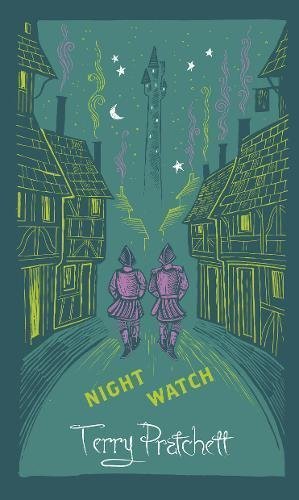
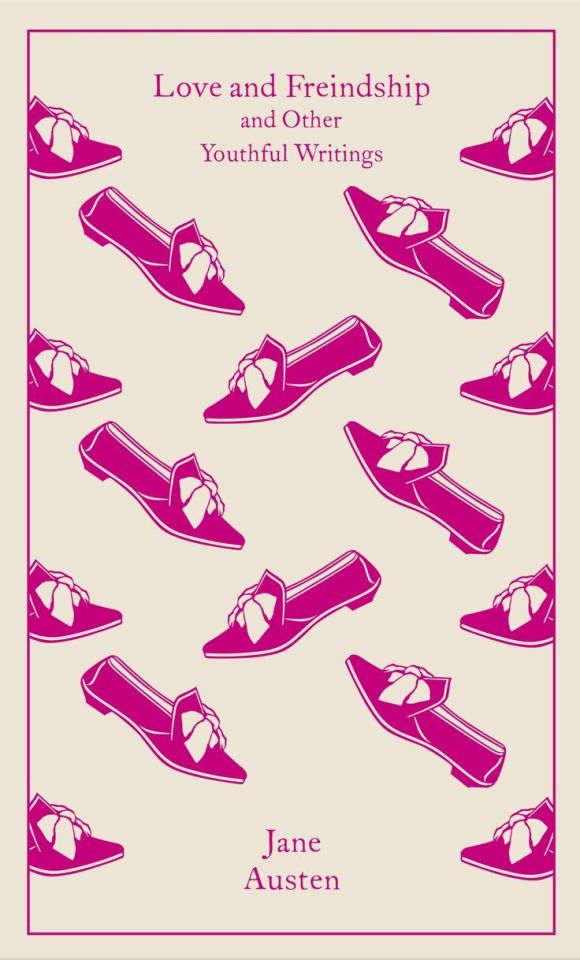

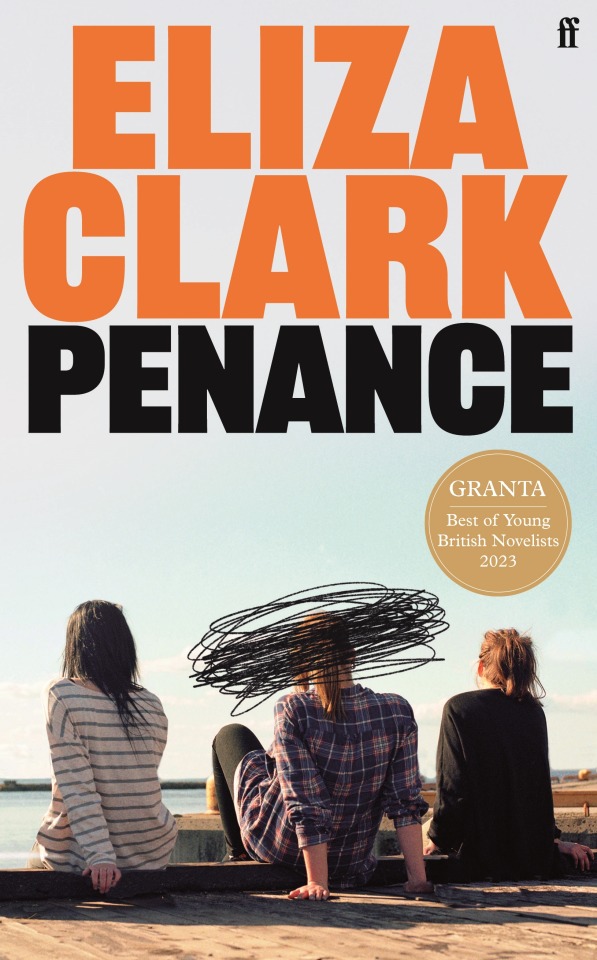




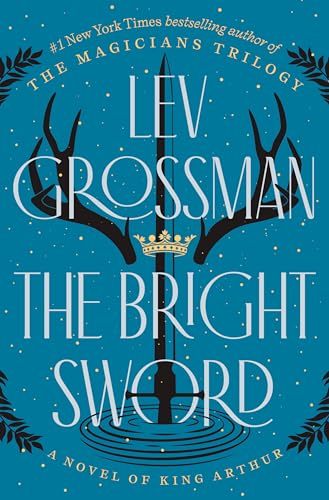

I was going to make a post of all my "favorite" books this year, but instead I decided to go with my "noteworthy" books of this year, the ones that stuck in my head when I look back over what I read. I steered away from negativity, so while a couple of these weren't 4 or 5 star reads, they still stuck with me for positive reasons and gave me stuff to think about! I had a fair share of 1 star books this year too, but I'll leave that for my goodreads if you're curious to read me be a hater! lol. See below for some thoughts on each!
~~~
The Spear Cuts Through Water by Simon Jimenez: new all-time favorite. If you are someone who loves the craft of the novel, the complexity of language to impart meaning, if you want a story that iterates, that invites deep thought and deep contemplation, you have to read this. It's one of the most cleverly and expertly constructed works of fantasy fiction I've ever read. The world-building, characters, and plot are all vivid and unique, and the woven narrative structure is a true masterpiece. I think this stands head and shoulders above every other work of fantasy I read this year, and I'll be thinking about it and re-reading it for a long long time.
Lord Byron's Novel: The Evening Land by John Crowley: This one had been on my tbr for a million years and I finally got to it this year. It's a perfect book 2 me even though it's pretentious as hell lol. It just happens to be pretentious about stuff I love to think about. When a contemporary author borrows the style of a known master with the English language and does it in a way that feels authentic and loving, I'm always impressed and interested. It also has this specific trope of "finding the lost works of the masters" and uncovering interesting secrets about the past that I always love. And I learned some stuff about Ada Lovelace, to boot!
Greta & Valdin by Rebecca K Reilly: I have a lot of friends who are allergic to trying literary fiction and this is the book I would pitch them to try, because it's not a huge bite to chew on but it does give a good example of the gifts this type of book can offer. It's about people my age in my current moment, queer and disaffected and confused and scared, but trying so hard to find joy. It's a story about a loving and somewhat wacky family that manages to never tip over into being too tropey or saccharine. It gave me goosebumps and it put the biggest smile on my face.
The Unconsoled by Kazuo Ishiguro: If you ever wanted to read a book that feels like having a confusing and disorienting and anxiety-producing dream, read this book. I don't even know how much I "liked" it or how to articulate everything going on about it, but it's about, like, disappointment? Suffering disappointment and disappointing others, and getting in your own way. And it's about parents failing their children, more specifically. And it's funny as hell, as Ishiguro usually is.
Prep by Curtis Sittenfeld: This was one of the bigger surprises for me this year, because it's my third Sittenfeld novel and I pretty strongly disliked the other two I've tried. But this was a book club pick so I sighed and resigned myself to another mediocre read. And instead, I really really liked it! I think the thing that sticks in my head most, months after reading it, is how it accurately captured something super painful and true about being a young person who doesn't know how to behave, and who is afraid of what other people are thinking of you. This is one of those books where the protagonist is not "fun" to hang out with in the traditional sense, she's often incredibly infuriating. But gosh, is she hashtag-relatable all the same.
Night Watch by Terry Pratchett: I have slowed down a lot in my quest to read through the entire Discworld, so I only read I think two or three this year. But I finally got here, to one of the top-tier novels in the series, according to most people. And, yeah, I get why it's a favorite. Samuel Vimes, the man that you are. Love a book that can make me snicker at the funny jokes on every page but then also punch me in the solar plexus whenever it damn well wants to.
Love and Freindship and Other Youthful Writings by Jane Austen: Despite being an Austen devotee, I'd never really bothered with her juvenalia, and that was a mistake! This was so fun. This volume included Lady Susan too, which I also hadn't read. These pieces are less polished and obviously not quite as deep as her completed novels, but god, she's so fucking funny. And because many of these pieces were just jokey little gifts she was writing for her family and intimate circles of friends, there are some really saucy and bawdy kind of shocking jokes in here that never would have appeared in any of the published novels. You also see her trying out some tropes that she later refines in her more well-known works, and I love seeing a bit of how the sausage gets made.
Harrow the Ninth by Tamsyn Muir: I read Gideon last year, and Harrow & Nona this year. Harrow is definitely my favorite of the three because she's so fucked in the head, and I'm a sucker for a clever second-person conceit. This is the kind of book that is patting itself on the back about how clever it is all the time and I don't even care because I'm too busy giggling at the bizarre and depraved events playing out on the page. The part that sticks in my head most is probably Harrow and Ianthe fleeing the room in abject horror as Mercy and Augustine initiate a threesome with God. Truly hilarious.
Penance by Eliza Clarke: Tumblr-ites, you should read this, Tumblr itself plays a pretty big role in the plot, and you can tell that Clarke is (or was) a native or at least worked closely with someone who was. It's probably one of the best fictionalized version of fandom stuff I've ever read, even though it's... uh... about RPF mass-shooter fandom...... It's a disturbing read that takes the entire concept of True Crime to task in a way that feels complex and not overly scolding? Like, it's not a book that slaps true crime fans on the wrist but it does make you think about the role that our social fascination with violence can play in the lives of people who might need help they don't know how to access.
Cages by Peg Kehret: Middle grade re-read! This was one of my favorite books from childhood and I remembered a ton of details really vividly, but I'd forgotten how hard it goes with the alcoholic stepfather thing... and goddamn, this book is sad. I actually cried real tears reading it during the part about Lady having the love light in her eyes. I gave my cat lots of kisses on her little snoot after reading this.
The Accursed by Joyce Carol Oates: This was a re-read that I first encountered as a senior in undergrad. At the time, I liked the book and I wrote a term paper on it, but reading it again today just shows me how ill-equipped 21-year-old-me was, to grapple with the book's core themes around race. I was skittish about it a decade ago, and this time the book kind of... unfolded for me in a way that was really valuable and interesting. Plus, say what you will about Oates, she's a fucking excellent writer of prose, this is a very readable and interesting book. For those of you who have become Dracula-enjoyers over the past few years because of Dracula Daily, I'd super recommend reading this book as a companion to Dracula. It's a direct homage in some fairly obvious ways (one of the main characters is named Wilhelmina) and also an alternative exploration of some of Stoker's original theming.
The Left Hand of Darkness by Ursula K. Le Guin: Not a ton to say here, this was a re-read and it's obviously flawless, incredible, a Favorite of All Time. This time reading it, I was doing it with a small group and we met every other week, so we read it sloooooowly. It was cool, I really got to take notes and Contemplate the Text in a way I hadn't in prior readings. The big theme that jumped out this time around was all the dichotomies, everything a complement and an opposite. The travelogue aspect really stood out to me this time too, the planet of Gethen becoming a character on the page to me more than it ever has before. And talk about gorgeous writing, holy hell.
The Singing Hills Cycle by Nghi Vo: I read the first one last year, then three more this year, and I still have one left to go. These are really nice literary snacks, I guess you could say? I like the vibe, I like the simple yet powerful prose, I like the distinct and memorable characters. I'm interested in the theme of "why do we tell stories" (as Tyrion Lannister might say lolololol) and a few of my favorite books this year grappled with that as a core idea. These books have this classical, folkloric vibe to them that I greatly enjoy. I hope Vo writes a dozen more, I'll keep reading.
The Bright Sword by Lev Grossman: Okay, this one probably doesn't have the depth or staying power of most of others on this list, but I really enjoyed it and it fits in with that general theme of why do we keep returning to familiar stories and characters again and again? What are we learning about ourselves and our cultural identity through these familiar figures? This was also a text that did that "setting as character" thing really well, with the land of Britain having a presence all on its own, standing up to any of the individual characters. There's a moment in this book with Bedivere and Guinevere that made me cry, and be on the look-out for the most insane take on Lancelot du Lac I've ever encountered. Ever wanted to read a book where the fae folk engage in pitched battle with literal Angels of the Christian God? Then this one is for you.
Paladin's Grace / Paladin's Strength by T. Kingfisher: these are the lowest star rated books that made it onto this "2024 notable" list for me; I grappled with my conflicting feelings a ton on this one, so feel free to read in full at that link if you so choose. Short version is that these are pretty poorly written on the level of the sentence, the prose could use some serious polish and that was enormously distracting. But, when I set that aside and met them where they're at, I can appreciate them for some cozy fantasy romance. The thing that stuck in my head the most was the promise of the premise, there's a really cool back-story for the lead characters, and intriguing world-building being set up in this series, and it's that larger structural story that had me going back for book two. I think I'll probably get to the next couple books in the series before too long. I just hope one day that promise of the premise actualizes and provides a bit more intensity, because these were fairly tepid, if comforting, reads for me. I haven't been able to get the Smooth Ones out of my head though, that's for sure! So creepy!
~~~
So there you have it, my 2024 in review! There were plenty of other books I really loved reading this year, but I think this encapsulates the bulk of what got stuck in my brain, the stories I keep turning over and over in my head like a mental fidget toy. I'm excited to read more of some of these authors and strike out into some new territory in 2025!
10 notes
·
View notes
Note
Can you someday do a post about a very important question that always deeply fascinated me: How technologically advanced is Oz?
Wicked as a stage show puzzles me because it implies Oz has electricity, a broadcast radio system, and trains.
How much tech is present in Oz in the books?
Oh boy that's one COMPLICATED question... Now, before I start saying anything, I will point out that I am not an Oz expert by any means. I have not read all of the Oz books. However I do know an Oz expert that tackled the subject! He is here on Tumblr somewhere, but I know his Oz analysis and lore-exploration by his blogs. He started doing them more than a dozen year ago on vovat.livejournal.com ; and then he continued his Oz posts to vovatia.wordpress.com ; I know they have very, VERY helpful when it comes to my own knowledge of Oz, and he tackled several times the topic of technology in Oz and Baum's work, with quite fascinating analyses! So go check out these blogs, you might find some interesting info!
That being said, what can I tell you?
Since I haven't read all the Oz books I will stick to Baum's novels only - but before doing that I want to point out something... It is something I said in my previous Oz post (So you want to know about Oz 5), but the Wicked stage musical is part of a pretty big wave of 2000s-onward Oz adaptations that decided Oz was a steampunk world. I know you entertained yourself a pretty similar project of a Gilded Age Oz, if I recall correctly? And when you look at Oz adaptations, you have this wave of SyFy's Tin Man, and the Amazon series "Lost in Oz", and the graphic novel/animated movie "The Steam Engines of Oz", and more recently the show "Emerald City". Even "Dorothy and the Witches of Oz" had a steampunk-vibe to their Oz. It is kind of the modern direction to go.
Now back to traditional Baum's Oz... Does it have electricity? I don't think so. The Oz created by Baum is... it is something between a fantasy version of the late 19th century American countryside, and your archetypal fantasy land. The Land of Oz is mostly a huge countryside to be honest. Its lots of forests with woodsmen and wild animals ; it is lot of fields and orchards because most of Oz's economy relies apparently on farming ; the only other big industry seems to be metal-working (Winkies, the guy who made the Tin Man) and stone/gem-working (due to the huge presence of precious stones, though no mine or miner is ever descrbed in the Oz books) ; it is a lot of small villages scattered around the one big city that is Emerald City (or around big castles like the Tin Man/Wicked Witch castle) ; this all gives it a very medieval/feudal feel in structure... Though Baum really tried to give Oz originally a "fairytale feel" and thus you have the same historical madness typical fairytales have. For example, just like your typical Renaissance fairytales (a la Charles Perrault), you have mirrors and candies and porcelaine in Oz ; and yet, just like your also typical 19th century fairytales (a la brothers Grimm) you also have guns in Oz! Mind you the guns are rare and rarely used, they seem mostly to belong to the military cast (they are always wielded by soldiers or royalty bodyguards), and they are usually useless against the monsters and magical threats... But they do exist! But Oz seems to lack things like electricity of petrol or even steam machinery. At least in the beginning!
(In fact I had a chat with @artmakerproductions recently about fireworks in Oz. He wondered if the Oz The Great and Powerful idea of using fireworks as something non-existent in Oz could work with Baum's canon, and indeed, while the presence of guns implies gunpowder is a thing in Oz, there are to my memory no mention of fireworks anywhere in Oz... Maybe they appear at one of Ozma's birthday parties, but I couldn't find which one. Fireworks are evoked in his non-Oz/Oz-crossovered work "The Magical Monarch of Mo" but only as a comparison to how lightning appears in this country...)
Is there radio in Oz? Actually there is! In the opening of book 7, to get out of how he had written his way out of Oz in book 6, Baum explained his return to the series by "Oh yeah, Ozians got hold of the radio and now they send me radio messages about what is going on in Oz". So Oz DOES have some sort of radio equivalent. How, since there's no electricity or batteries in Oz? That's beyond me, but here's why it is difficult to say for certain what Oz's technology level is: Baum, as I said, started not giving a fuck anymore about continuity. As I explained the first two-three books are kind of solid in terms of continuity because they were designed as their own closed novels, but book 4 onward Baum just gave up any concrete effort at "solid" worldbuilding and went the "Fuck it, I'll add whatever I want" road. As such, don't expect any serious effort at making a cohesive technological system - Baum isn't Tolkien. He's the anti-Tolkien. That being said, another very interesting point when it comes to Baum's work is that, as you go through his fourteen Oz books, you realize how modern technology slowly creeps onto Oz. Baum was writing Oz book between 1900 and 1920 - and the technological evolution of these two decades quite influenced Baum. The addition of the radio element was one case of Oz "evolving"; in later Oz books there are also magical equivalents of television popping up. But if you want to see a concrete comparison, you can compare the first Oz book, "The Wonderful Wizard of Oz", with the last Oz book Baum wrote, "Glinda of Oz". The first shows an Oz so technology-lacking people are easily fooled by stage tricks ; while the last book is heavy on technology, with for example evocations of submarines, but it is a technology presented as a form of magic. Which leads me to my last point...
Does Oz have trains? Not by the time Baum wrote them ; though modern day adaptations and authors did add a handful of them to the Oz world (and you can also find things such as ray guns or time-travelling machines in modern Oz books so you know, it evolves with its time). But Baum did wrote about a carriage that did the entire tour of Oz for touristic purpose: that's one of the subplots of "The Emerald City of Oz", and how Dorothy shows her aunt and uncle all about the fantasy land. It is not a train, but you have already here the idea/potential for a train-like system here (even though it is rather a carriage/wagon drawn by a wooden horse that can never tire and doesn't eat). And here's my point: the reason technology is so weird in Oz, and why it is also lacking in many way, is due to Oz being filled with magic.
Most Ozian equivalent to our world's technology is, in Baum, powered by magic. There is no camera or surveillance system, but there are the Magic Picture or Glinda's big magical "spy on everyone" book. There are no lie detectors, but there is Glinda's pearl. The magic eye of the Wicked Witch of the West was explicitely compared to a telescope. Etc etc. Magic replaces most advanced technology around the Land. Advanced technology and mechanism do exist, and Baum was very fond of the idea of the... "magical mechanic" if I can say so. What he does is basically take an actual real-world technology, but take it to fantasy extremes - which notably is why the Oz books are considered early sci-fi. There's how the Tin Man came to be: Baum took the workings of actual real-life prosthetics for missing limbs, but pushed it to the extremes by making a "vintage android". There is how the Woggle-Bug came to be: a great scholar used a machine to project an enlarged image of a small bug on the wall. Quite ordinary right? But turns out the machine literaly enlarged the bug to a greater size - which is a very common sci-fi tropes (all those rays that shrink or enlarge things or objects). And while it is not an Oz example per say, Baum gave us the most blatant example of "magical technology" with the realm of Ev, where lived Smith and Tinker, the inventors of many fantastical automatons, first of which being Tik-Tok, a sentient automat that is considered one of the first robots of modern literature!
So... On one side, Baum tried to show a land that would not advance technologically because magic was there and much more powerful. It is the line by the Good Witch of the North, about how Oz still has magic because it is not "civilized", and one of the traits of "civilization" is advanced technology. Take how guns are treated in Oz: they exist but they are not made a big deal out of, and in fact prove quite useless among the many magical items and beings. And yet, on the other side, Baum's Oz is the literal proof of the law "Any advanced technology is magic" ; or rather a whacky incarnation of this principle, because indeed, the most advanced form of technology in Ozian lands work by fantasy and extravagant sci-fi rules (Tin Man, Tik-Tok), while most of the great spells and magic items of Oz are fantasy equivalents to our real-world technology (the Magic Picture, or even the Gump which works as a fantasy equivalent of flying machines).
28 notes
·
View notes
Note
Top ten favorite Orcs? Either specific characters or a given setting’s take on the species as a whole.
I'm not sure I have enough strong feelings about Orcs to really make an interesting list of ten, but what the hell I'll try.
Tolkien's orcs - not just LOTR orcs, but specifically orcs as written by J.R.R. Tolkien - are pretty high up there for me. I've probably mentioned this more than enough on this blog, but I'm still moved by the moment in The Lord of the Rings where we get this conversation between two orcs when their bosses aren't around, where both of them commiserate with each other about how shitty being drafted into Sauron's war is, how they long to go back to their simpler life as mountain bandits, and how, maybe, if they could find a way to escape being caught by their superiors, they could run off and find someplace far from the war to settle down together. Their names are Shagrat and Gorbag, and later in the book one of the heroes finds them among a pile of dead orcs, their dream of a simpler life tragically unfulfilled. I bring this up because, for all the flak Tolkien's cosmology gets for codifying the fantasy trope of "Always Chaotic Evil" races, there's a lot more moral complexity to his "evil" races than most people think. The orcs we meet in his stories are universally pretty nasty people - even Gorbag and Shagrat can't conceive of a simple life that doesn't involve killing people for their valuables - but it's very clear this is a result of the culture they are living in, which, if you get nerdy and read up on the Lore (TM), is one that has been specifically designed by the Middle Earth equivalent of Satan to turn all living things in it into tools of warfare - a world that exists solely to serve as a vast machine of industrialized conquest and mass murder. And it makes them miserable. Orcs don't like living this way, even though it's the only way they know how to live. They are at once victim and villain, and that's explicitly the canon way to look at them in the text. So it kind of sucks that their reputation in pop culture - and how they're presented in most adaptations, including good ol' PJ's film trilogy - is as one-dimensional evil henchmen, because they do have more going on than that in the books themselves, and it enriches the themes of the story when those dimensions are included.
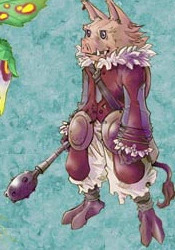
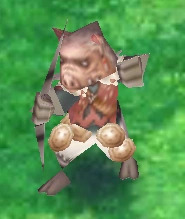
The orcs in Rune Factory are probably my favorite from a design standpoint. I'm kind of neutral at best with the standard "green skinned humans with optional tusks" look of most orcs. There's nothing wrong with it, but it doesn't thrill me either, existing in the same nebulous space as, like, traditional fantasy elves, dwarves, and hobbit expies - I understand why they're classics, but they feel kind of boring when you've got other options on the table. So seeing these guys when I booted up my first Rune Factory game was a revelation - finally, orcs that look INTERESTING! And they're so cute, these gnarly little Jim Hensen/Brian Froud style pig people. And they'll help you water your plants! A+ Tier orcs as far as I'm concerned.
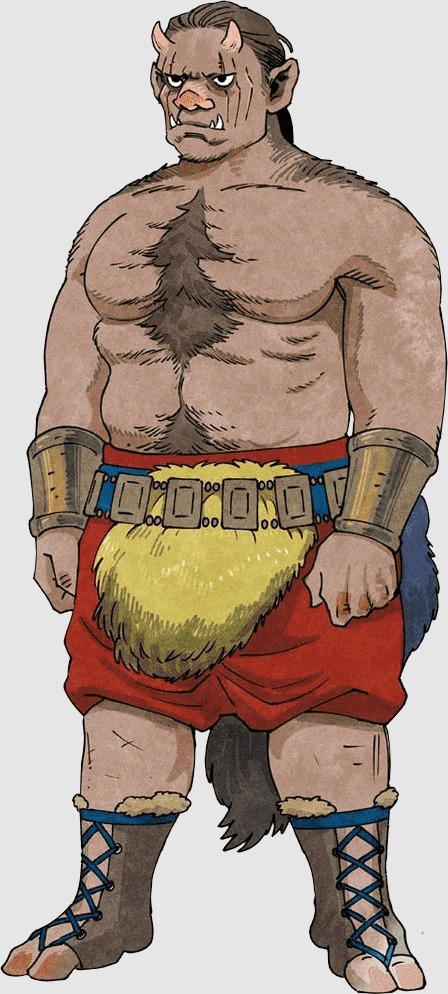
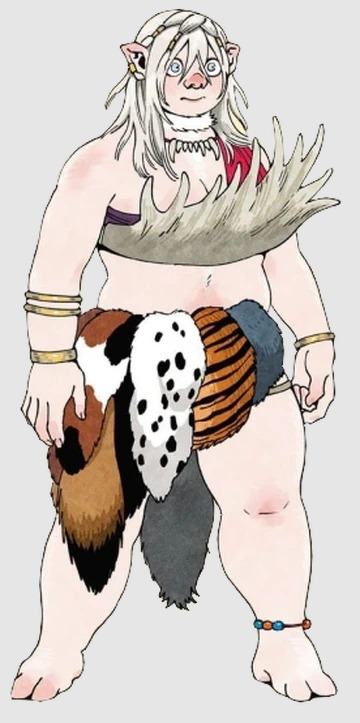
Dungeon Meshi found a good middle ground between "gnarly boar people" and "humans with tusks" that I really like, and while the orcs aren't given a whole lot of focus, what world building we do get about them is pretty great, taking a lot of the classic orc tropes and giving them that Ryoko Kui caliber thought and detail that makes them so wonderful.
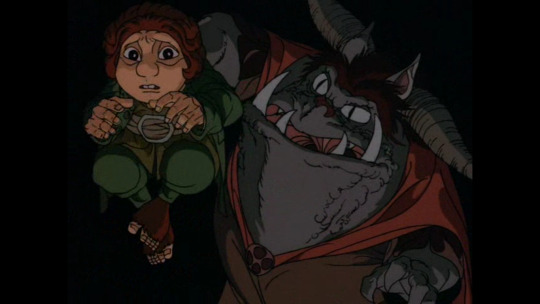
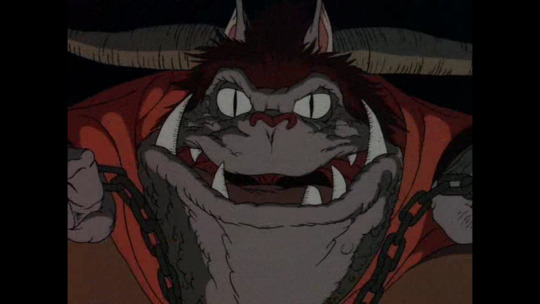
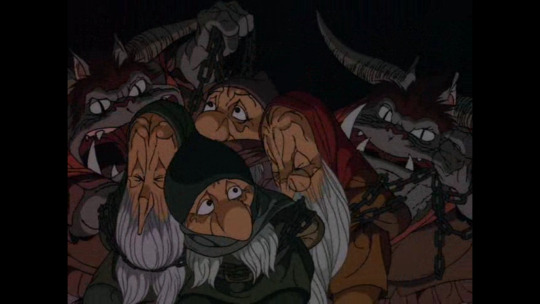
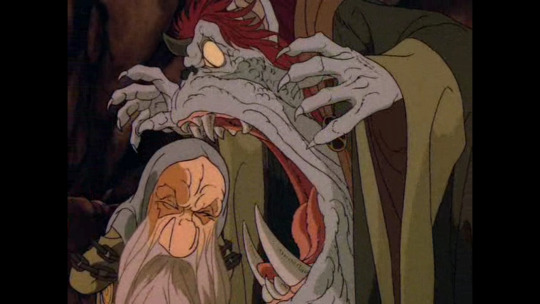

What else... well, ok, my brain still categorizes these guys as "goblins" rather than "orcs," but since the two are more or less synonymized in both Tolkien and the Rankin Bass adaptations of his work, I guess I can include them. They're one of my favorite designs for goblins of all time, and since I generally like goblins more than orcs, I guess this makes them my favorite orc design by default? I just love them, nasty little toad people.
youtube
The 1980 Return of the King movie in particular is one of the few adaptations that keeps Tolkien's sympathy for the orcs in tact, with Frodo even having a dream sequence about living in a world where his run in with orcs is fully pleasant, each of them waving at each other as they cross paths, content to share a beautiful world together.
youtube
And while it adapts the parts of the text that take place after the deaths of poor Shagrat and Gorbag, it still manages to work in a moment where the orcs lament their lot in life by way of the infamous "Where There's a Whip There's a Way" song written just for the film. I know this song is generally viewed as "bad" and corny and whatever, fuck that, I unironically love it. It's my wakeup alarm for workdays. I am these orcs five days out of the week.
What else...
youtube
So, like, kind of a cheat I suppose, but the Darkspawn in Dragon Age take a lot of cues from Tolkien's take on orcs, right down to seeming like they're just always chaotic evil at first glance, and also being the product of Supernatural Crimes Against Nature by semi-divine powers. And indeed, in Dragon Age Origins you're basically given no reason to view them as anything but evil obstacles to destroy, especially when you learn the body-horror involved in how they reproduce (it's more in the vein of Slither than Goblin Slayer, for those unaware - grotesque but, thankfully, not in that way).
But the big ol' DLC for the same game, called Dragon Age Awakening, throws a big monkey wrench in that view of them. We meet Darkspawn who are capable of speech - ones that have been broken free of the evil hivemind their species is ruled by, and, like freed borg drones, are now at a loss of what to do with themselves. They are, like Tolkien's orcs before them, a people who were made for war and violence, and yet still crave something more than that when given the chance to think about it. It's something that hasn't been followed up on much since, sadly, but it's a damn cool take.
What else...
youtube
I'm probably the only person who still remembers this movie, especially with any fondness, but I liked the orcs in the Warcraft movie directed by David Bowie's son. They were given a lot of nuance and I honestly think their parts of the film were by the far the best. Actually I remember liking that movie a lot despite some of its pacing issues, I should revisit it.
Ok that's not ten takes but I feel like there are at least 10 designs on display here so I'm calling this done.
26 notes
·
View notes
Text
I made a Patreon lol.
Here's the free sample post:
THE CREATION MYTH OF KILL 6 BILLION DEMONS
INTRODUCTION
I love fantasy religions. I love it when fictional humans try to understand worlds like Brandon Sanderson’s Cosmere and Tolkein’s Middle Earth through a religious lens—especially because in those books and in many others, the fantasy religions are somewhat true, and somewhat false. It’s really fun to look at a fictional universe through the eyes of a character who might not see things objectively. Religion usually plays a role in that. But, if I’m being honest, a lot of fantasy religions are just Christianity wearing a fun hat. Don’t get me wrong, I am fascinated by Chrisitianity, and I really enjoy a lot of fantasy versions of Christianity. But it’s a great special treat when a fantasy story goes the extra mile and portrays another concept of the divine. That’s one of many reasons that I love the webcomic Kill 6 Billion Demons. The webcomic’s fictional religion Atru has parallels to Taoism, Gnosticism, Advaita Vedanta, theothanatology, Biblical divine nomenclature, the list goes on. I just threw a lot of big scary words at you, but I promise, this is a beginner level essay. I’ll break everything down into bite-sized pieces. I just wanted to list out some of K6BD’s religious influences to show that they are complicated, and diverse.
This is specifically a essay about the creation narratives. K6BD is an amazing comic—later on, it tackles questions about time, free will, and optimistic nihilism, but I won’t dig into that stuff here. Those things would require their own essays. Here, I’m going to try to explain how the seven-part world came to be. More specifically, I’ll examine the stories that White Chain, Cio, Michael, and the old devil’s tale tell us; then I’ll look at fictional holy texts found in the Concordance.
I’ll also compare and contrast with a lot of real world religion and philosophy. I want to be clear that the creator Abaddon and I have never spoken. I don’t know where he got most of his inspiration. I’m not revealing any information that wasn’t already available, I’m just compiling it and offering my own thoughts. Unless I specifically quote Abaddon, assume that I’m not even talking about his inspirations. I’m drawing parallels because it’s fun, even though it probably won’t give us new insight into how the text was created.
I promise I’m not trying to convert you! I genuinely don’t want to make other people believe the religion that I believe—or any religion at all. I’m just trying to show you how understanding some real world religious and philosophical concepts can deepen your appreciation of K6BD. Obviously, there will be tons of spoilers, so go read the webcomic if you haven’t already. It’s absolutely genius.
Lastly, I want to say I will discuss suicide and murder.
Ok, let’s get started.
PART ONE: THE FIRST AND GREATEST DIVISION
Let There Be No Genesis
White Chain begins the history of the universe with the words, “Let there be no Genesis,” closely echoing the in-universe fictional Psalm I. “For indeed, there was [no Genesis]. God has always existed and has never existed.” As White Chain tells her story, we are shown the god YISUN. This figure is sometimes described with it/its or she/her pronouns, but for the sake of simplicity, I’m going to follow the example of the fictional Psalm I, and use he/him. I might call him “YISUN” or “God” with a capital G depending on the context.
YISUN was eternal, and the “undisputed master of the entire omniverse.” He predates everything else, and without him, nothing would exist.
YISUN has at least twelve bodies, probably more. Some are smiling, some look mad; some resemble insects or animals; most hold weapons; and all are different colors. The central white body has four arms. Abaddon has said that YISUN’s appearance is directly inspired by the Hindu god Vishvarupa. Hindu gods are frequently depicted with multiple body parts, an artistic tradition that Doris Srinivasan calls “the multiplicity convention.” She explains some of the religious and artistic reasons that many Indian gods have multiple body parts in her book “Many Heads, Arms, and Eyes: Origin, Meaning, and Form of Multiplicity in Indian Art.” The tradition of Hinduism is long, and diverse, so the multiple limbs in one text can mean something very different from the multiple limbs elsewhere. Srinivasan closely examines a vast expanse of Indian history, and I don’t have time to present all her ideas. I would like to specifically focus on the interpretation that multiple limbs represent the manifestations of a singular godhead.
Srinivasan writes that “Multiple versions of a myth are facilitated by the idea that there exists multiple aspects or manifestations of a godhead.” Think of the difference between Greek and Hindu goddesses. Bruno Snell suggests “that these four women signalize the four aspects of all womanhood,” but Srinivasan qualifies his interpretation. The Olympian women “are not multiple forms of [one] Divine Woman, as is the case in Hinduism.” Artemis and Athena are different people who are both women, plural. Parvati, Sati, and Uma together are Woman, singular. Zeus, Demeter, and Poseidon are gods, plural. Shiva, Vishnu, and Krishna are God, singular. That’s not how all Hindus see things, but it is one Hindu perspective that I find especially comparable to K6BD.
Similarly, the multiple bodies are only manifestations of a single God: YISUN. All of his bodies are a single person. In Hinduism, the plurality of the divine can be seen as empowering and liberating. Multiple body parts signify that the god is a well-rounded entity. But Abaddon makes it look like a curse. He turns the artistic convention around. Using the same symbolism and metaphysics, he tells a radically different story. As White Chain says, “Being was only circular.” “YISUN had no equal… It was a wretched life, without meaning or perception. Imagine infinite stories to tell… and nobody to tell them to.” Perfection is lonely. At this point, YISUN is the only thing that exists, and that can’t be fun. All those arms and heads cannot satisfy YISUN’s need for companionship. It’s fascinating to me that when White Chain says YISUN had no one to whom it could tell its stories, Abaddon chose to illustrate multiple heads right next to each other. Even if those heads told each other stories, the speaker and the listener would still be the same person. Dissatisfaction with isolation is why YISUN created the world.
Although not all Hindus follow the school of Advaita Vedanta, in this case, I think it will be helpful to compare and contrast with Advaita. As Ram Shanker Misra writes in “The Integral Advaitism of Sri Aurobindo,” “Brahman [ is] perfect, absolute, infinite, need[s] nothing, [and] desir[es] nothing…” Brahman is full of all perfections. And to say that Brahman has some purpose in creating the world will mean that [Brahman] wants to attain through the process of creation something which it has not. And that is impossible.”
But that’s exactly why YISUN created this world. He wants to gain something that he does not have: companionship.The universe is God’s escape from himself. There was no Genesis, but there was “the first and greatest division: division of self”: “God committed holy suicide.”
2. The Divine Suicide
White Chain’s story is similar to Friedrich Nietzsche’s famous claim that “God is dead,” but Nietzsche did not mean God was a real entity that had literally died. He meant that intellectually, it was impossible to continue believing in God, and that all intellectual achievements founded on belief in Him had to be abandoned. Nietzsche’s claim is a famous example of a philosophical school of thought called death of God theology, also called “theothanatology,” which means “the study of God’s death” in Greek.
“Death” can mean a lot of different things in this context. Sometimes it’s metaphorical, sometimes it’s literal, and usually, it’s a very confusing mixture of both.
Nietzsche proposed the death of God as a social claim about humans. He’s talking about what we can believe, what we should do, and what we need to accept. God never really existed, but as religion loses followers and influence, even the idea of God has begun to “die” because it no longer has power over the real world.
“Death” can also mean God exists, but in a way radically different from what people usually mean when they say “God.” The Rabbi and philosopher Richard L. Rubenstein thought God exists as a “ground of being,” but not as a supernatural entity that made a covenant with Abraham. Rubenstein proposed the death of God as an intellectual change in what humans think the word “God” means.
And, finally, “death” can just literally mean “death.” The Protestant theologian Thomas J.J. Altizer wrote “we shall understand the death of God as an historical event: God has died in our time, in
our history, in our existence.” This isn’t a social claim about humans—it’s a metaphysical claim about God.
Death of God theologians usually mean more than one thing when they say God is dead. Nietzsche wasn’t just trying to convince Christians to become atheists; he was also trying to convince many atheists that they disbelieved in God in the wrong way. Altizer had radical thoughts about what human beings are able to believe.
White Chain means that God is dead in the literal sense. She is proposing a metaphysical belief that God, as a historical figure, chose to actually kill himself. White Chain is not rejecting or critiquing religion—she’s asserting that her religion, in which God has died, is fact.
You can see slight parallels to Nietzsche, Rubenstein, Altizer, Hegel, Zizek, and Blake in White Chain’s version of the fictional religion Atru. But there is no better comparison than the king of sad philosophers Philipp Mainlander.
Mainlander was an atheist—but not in the sense that people usually mean when they say “atheist.” Mainlander believed that there was a God at some time, but that time is now over. There isn’t a God anymore. Mainlander is pretty unique among death of God theologians because he explicitly describes God’s death as a suicide. Whittaker explains that Mainlander thought “[a]ll things have their origin in what may be called… the ‘will’ of the absolute being… to annihilate itself.” Essentially, the cause of the universe is God’s suicidal desires.
God was a “real unity,” but his death caused a “collective unity”—that’s the universe where we live now. God had been a total and undivided One, but now the universe is made of distinct parts. God cut himself apart into the pieces of the universe. God created the world by becoming it, and he became the world by dying.
Mainlander said “the knowledge that life is worthless is the flower of all human knowledge.” He thought suicide was desirable, and ultimately, he put his money where his mouth was. The biggest difference between Mainlander and White Chain is that she doesn’t seem to think ordinary people such as herself should follow God’s suicidal example. Even beyond the views of a specific character, the story of Kill 6 Billion Demons reads as an affirmation of life’s beauty and value.
But the webcomic clearly argues that making a better world is a bloody project. So it should come as no surprise that making the world itself involved bloodshed. First and foremost, the blood of God. What’s so interesting to me is that both White Chain and Mainlander equate God’s suicide to the creation of the world. Our life comes from God’s death. Creation and destruction aren’t opposites—they’re different ways of looking at the same process. At the end of Book 2, Allison destroys Mottom’s evil tree and a lot of her palace—but this destruction is also part of the creation of a more just and free world.
So, what did God’s destruction create? What came after YISUN?
3. The Duality of Un and Yis
The destruction of the total unity creates duality. I know that’s a little confusing because YISUN had many faces, but remember that behind all of those faces was one God, and only one. Not anymore. “From division was birthed duality. White Un, Lord of empty and still places, master of all that is not. Black Yis, infinite mother of the rampant flame. Master of all that is''
I cannot avoid comparing the White and Black gods to the Yin and Yang—a spinning black and white symbol usually associated with the religion Taoism. Yin and Yang represent a cosmic duality. Yin is associated with femininity, darkness, passivity, and even numbers, among other things. Yang is associated with masculinity, light, activity, and odd numbers, among other things. Mainstream Taoist philosophy asserts that the universe can be understood through duality. So, why are these pairs important? And why do things get paired together in the first place?
As is written in the foundational Taoist text the Tao Te Ching, “Being and non-being create each other. Difficult and easy support each other. Long and short define each other. High and low depend on each other. Before and after follow each other.” What’s so interesting about the pairs is they “create,” “support,” “define,” and “depend on” each other. Black can’t exist without white, and white cannot exist without black.
As the Encyclopedia of Philosophy puts it, “...yinyang is emblematic of valuational equality rooted in the unified, dynamic, and harmonized structure of the cosmos. As such, it has served as a heuristic mechanism for formulating a coherent view of the world…” Essentially, neither of these opposites are “dominant” or “truer.” Choosing one side won’t help you understand the universe because the universe is their partnership. Their equality gives “structure to the cosmos.” That structure is order, not chaos, but it is differentiated. There are two different things: Yin and Yang. They contradict each other, but at the same time, they make the universe. Yin and Yang are a productive paradox.
I’d like to return to the notion that “being and non-being create each other.” At this stage of creation in K6BD, UN and YIS could not exist without each other. Their very existence is the fact that they are not a unity. If there was only one of them, then there wouldn’t have been a division—and they are nothing more than the product of division. Just like how being and non-being create each other, the Master of All That Is and the Master of All That Is Not create each other. YISUN was characterized by his totality—he was the total sum of the omniverse, there was nothing else. After the division, Un and Yis experience otherness. The first otherness in the omniverse. It’s difficult for them to find balance—in fact, they immediately went to war for seven years. At the end of their seven-year war, Un and Yis made love for seven days.
I want to be very clear that this is not a depiction of actual Taoism. Yin and Yang are not gods with faces and minds. Notably, the Tao Te Ching asserts that yin and yang are “older than God.” so make of that what you will. But I think Taoism is thematically relevant to this era. Two opposites have to come into balance with each other. The whole universe is a duality of interconnected forces.
K6BD repeatedly emphasizes the need for community. As Allison says at the end of King of Swords, “I couldn’t have done this without any of you… We make mistakes. We learn from each other. We all still have so much to learn. Once I saw that as a weakness, now I’m certain it’s not. Someone who lives still thinking like that… struggling to do everything themselves… I can’t help but think how alone they must be.”
YISUN had to do everything all by himself, and we saw that Allison was right—isolation was a struggle, even for God. But the struggle is over, and in its place is duality. Partnership. The first community.
These are the first four parts of a fourteen-part critical essay. You can read the rest here.
Bibliography is on the free Patreon post.
35 notes
·
View notes
Text

please support this blog
🦇 Payback's a Witch Book Review 🦇
Rating: ⭐⭐⭐⭐
❓ #QOTD What's something from your family history you're proud of?❓ 🦇 Emmy Harlow is a witch but not a very powerful one—in part because she hasn't been home to the magical town of Thistle Grove in years. When a spellcasting tournament approaches, tradition pulls Emmy back. On her first night home, Emmy runs into Talia Avramov—an all-around badass adept in the darker magical arts—who is fresh off a bad breakup...with the ex that encourages Emmy to leave in the first place. When she learns her best friend had her heart broken by the heir to the most powerful magical family in town as well, the three vow to take their revenge.
💜 Lana Harper's prose is enthralling from the get-go. If you're looking for some truly magical witch lit, this is it! Let's break it down. ⤵ ✨ Characters: Our FMC, though a witch, is human in her desire to break away from the small town she's always known, from a legacy that seems to be holding her back, to chart her own path. The surrounding characters create a cast BRIMMING with possibilities (as evident by the continuation of this series, which follows different couples). I'm also glad the payback plot, nor romance, eclipsed Emmy's character development. ✨ Plot and Pacing: This story is the perfect balance of plot and romance, which keeps the pacing moving forward without an exhausting lull. However, I would have enjoyed seeing more of the magic at play, namely between the competitions. Also, give me a "ladies ban together for revenge against an ex" plots any day. ✨ World-Building: Thistle Grove is, in itself, magic. Harper does a superb job at creating a cozy small town that doesn't RELY on magic to feel magical. I would have loved to learn more about each family's unique magic systems, but I'm sure the rest of the series delves into that. ✨ Romance: From the moment Emmy describes Talia's translucent gray eyes (which make her look like a tundra wolf), the swooning starts. The chemistry between them is palpable yet sweet. Though Talia has a bad-girl exterior, I love her heart of gold and warmth. ✨ Mystery/Suspense: I will say the "mystery" regarding the founding families is a bit obvious. Notetakers and writers have more power than history ever gives them credit for. ✨ Tone/Prose: Harper's prose gives this story its power. Though a light, playful read, the word choice is still detailed and captivating, drawing readers in to explore Thistle Grove and the secrets it keeps.
💙 Unfortunately the story is a little predictable, from Emmy's family secret to the competition. It's Emmy and Talia's fight that bothers me most, though. They both stepped into the relationship knowing neither was willing to change their minds (Emmy about leaving, Talia about staying), without leaving room for a mature conversation on the subject or compromise. The third-act breakup felt juvenile, especially when the resolution is so quick and easy. I also don't love a villain without purpose. The ex-boyfriend is entitled, yes, but what else? His characterization was a little two-dimensional, when there could have been a hint of the pressure he was under from his family to carry the mantel. What about the Blackmoore family's plot to steal business from the other families? There's more there, and I hope the rest of the series delves into it all.
🦇 Recommended to fans of John Tucker Must Die and Practical Magic.
✨ The Vibes ✨ 💜 Queer/Sapphic Rom-Com 🌙 Bisexual FMC 👻 Witch Lit 🍁 Small Town Romance 👻 Paranormal/Fantasy Romance 🌙 Magical Competition 💜 Part of a Series
💬 Quotes ❝ “I’m in, witches. Let’s run amok.” ❞ ❝ I shook my head, not trusting myself to speak. A dazzling smile streaked across her lips like a lightning bolt. ❞ ❝ The girl who embraced darkness, tended and cared for the phantoms that lived within it, while shedding such a scintillating light that it was damn near impossible to look away from her. ❞ ❝ "It’s like you fucked the sass right out of me.” ❞ ❝ “You, Emmeline Harlow,” she said, eyes locked on mine, “are so extremely fucking beautiful it hurts my soul.” ❞
#book review#book blog#booklr#queer books#sapphic books#sapphic romance#queer book review#book reviews#batty about books#battyaboutbooks#book quote#book quotes#book series#witch lit#spooky books#spooky#spooky season#witchy books#witchy vibes#knitting#bisexual romance#bisexuality#bi books#bi book
8 notes
·
View notes
Text
Another part of Icewind Dale that's been fucking grueling so far though... Ngl a part of me is actually fascinated by the historical fantasy worldbuilding done by A Certain Kind Of History Dude who clearly has no idea how history has ever actually worked. The hoops they jump through to convince you that history has never been what might be called "political" is, in its own way, kind of impressive.
Conflict has never been about stuff like colonialism, it's all about nebulous human themes like Tradition. Conflict is about Economy and Economy never involves anything like class or culture. Only trout. The entire machinations of this society revolves ONLY around trout. (I'm now genuinely harping about the trout, it's just really dumb ok.) Conflict is about different groups just being fundamentally different, usually with a clear evil one. Conflict is about all groups being greedy about THEIR FUCKING TROUT because it's just a nebulous human condition to be greedy. Racist also. And poor people are just poor because they aren't ambitious, as a little aside.
It's so...... ashistorical but also deeply uncurious about our own actual real life world right now.
So many "high" fantasy books are like this. The Certain Kind Of History Dudes have too much power in this genre. They get praised for their worldbuilding and it's just the most shallow understanding of how anything works ever.
And more nefarious is the way this seemingly innocent ignorance so quickly and easily justifies stuff like "well, it's totally chill for good guys to kill bad guys... because they're from a bad guy society." Drizzt will tie himself in knots if he has to kill the worst human you can possibly imagine, but swats down random orcs no problem. The way that seemingly creates no cognitive dissonace at all for these writers needs to be studied in a lab. It's all fun and games when we're talking about monsters, but then you think about how that translates into the real world using the exact same mechanisms and that isn't fun at all is it? The ways racist men can tell themselves they are good people follows similar mental gymnastics. Why are "humans" deserving of infinite grace and forgiveness even at their most evil but "orcs" are understood to be inherently a lost cause? Why really? What is that mechanism really? It's been particularly egregious as I'm trying to slog my way through The Crystal Shard because, like, we can generously say that the "barbarians" are based on vikings, but ngl all I'm getting from this dynamic is Salvatore playing "cowboys and indians" but with white people. The general underlying vibes... And maybe that's what I'm trying to get at with what I'm describing in the fantasy races too. If you take off the mask, it all just feels like "cowboys and indians." A trope so deeply embedded in American genre fiction which has always just been incredibly racist this whole time.
These books are such whiplash because unfortunately I do love the characters but boy I wish I could save them from these books sometimes. The Crystal Shard has been soooo much worse than the other books so far imo, so I'm hoping the series chills tf out again generally.
#this has soured my enjoyment considerably but unfortunately i am cursed with investment at this point#jarlaxle come back#everything's going to shit without you babygirl#also where is catti brie tbh#i feel like catti brie isn't in this book because if she was she'd just be like 'everything happening here is macho and stupid'#im just saying maybe we didnt need wulfgar at all and you couldve just given the cool hammer to your daughter just saying#legend of drizzt#racism cw#fantasy racism cw
23 notes
·
View notes
Note
hiii, i was wondering if i could request a matchup for atla.
since i'm bi i don't have any gender preference. i'm 5'6, with brown skin and 4c black hair that i usually keep in box braids. i'm like halfway between chubby and skinny. i have brown eyes and plump lips with a rather flat nose. my love languages are acts of service and physical touch. i like playing tennis, doing makeup and reading, especially fantasy books. i also enjoy drawing even though i suck at it. my ideal first date would be a romantic picnic on the beach. when i look for a partner i focus mstly if our humour and values match up. i don't really care about the rest. i speak 5 languages fluently and i'm the oldest sister (i have two little sisters) i loathe bugs especially flies.
i would really appreciate getting a matchuo but no pressure to you or anything
💞
your matchup is . . . zuko!!
fire lord zuko who thinks that you deserve the world and more! (because you do)
dates with zuko down to the town’s marketplace! your favorite part is visiting the local artisans, you and zuko love supporting their businesses. he knows you so entirely well because when you even glance slightly at some sort of pottery or jewelry with a certain look in your eye, zuko knows that he has to get it for you.
most of the times, you always fight your boyfriend about him buying you things, but it always ends the same: him successfully pulling out the money and you walking away with a new bag in hand.
zuko would spend the entirety of the fire nation’s national funds if it meant making you happy!!
due to both of your busy schedules, you two often try to help each other out in terms of chores and other smaller acts of service.
despite having maids and servants around the palace, zuko never lets any of them into his personal office. he has a very particular way of organizing his documents and papers, and he finds it too tedious to explain every single aspect of his methods to them. but over time, after spending many long sleepless nights with him in his office, you’ve come to recognize and memorize his organizational habits.
so after weeks of zuko working tirelessly in his office, probably more earth kingdom affairs, he’s burnt out and most definitely too worn out to even think about the mess that remains in his work space. with a little free time in your schedule, you decide to take on the job of organizing his office, carefully sorting everything away into its rightful spaces.
the look in his eyes when you take him to his office for “a surprise” makes everything worth it.
zuko would appreciate somebody who’s well versed in other languages! when it comes to diplomatic affairs with other nations, he values your input due to your knowledge in international customs and traditions.
he also relates to you on a deeper level when it comes to siblings! while the sibling dynamics may be vastly different, zuko can relate to being the eldest sibling and the struggles that come with it.
it’s imperative to zuko that he maintains a strong relationship with your family. he always goes the extra mile to impress them! whether it be importing some sort of flower that's native specifically to the water tribe or commissioning clothes to be made for them from his own personal seamstress, he just wants to make sure they’re happy.
despite being the literal fire lord, zuko was so so so incredibly nervous meeting your family. he couldn’t stop checking his hair in the mirror or making sure that the gifts he brought for them didn’t somehow magically disappear out of the gift bag. but honestly, zuko had no reason to worry because your parents love him as if he were one of their own, and he couldn’t be more grateful.
your second contender was . . . sokka!!
. . .
author's note: i kinda wrote this with post-atla show zuko in mind, so when he finally becomes the fire lord at the end of the show! hope you enjoy nonnie! <3
9 notes
·
View notes